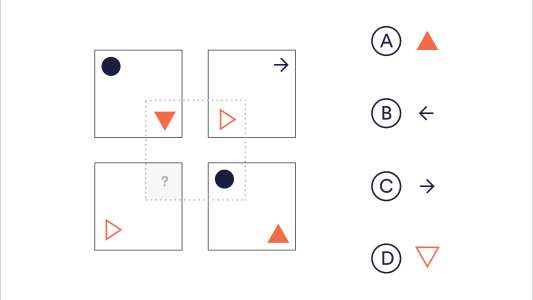Diagrammatic reasoning tests are psychometric tests that assess a candidate’s ability to interpret sequences of shapes, patterns and figures.
The questions centre on deducing the rule, or rules, governing a sequence and extending or reapplying these conventions to determine the correct input or output. They test a potential employee’s ability to think logically and rapidly apply concepts to new situations.
Although often conflated with abstract reasoning tests, the diagrammatic variety differs slightly. Whilst abstract reasoning tends to focus upon symbols and shapes, diagrammatic reasoning questions may also include letters and numbers, as well as operators or processors – adding to their complexity.
Diagrammatic reasoning tests are a useful tool for determining whether applicants have the skills of spatial deduction and agile problem solving required for a role. They were once predominantly administered for jobs in sectors such as engineering, but are now increasingly present across various industries.
Our tips below will help you to approach your diagrammatic reasoning test in the most constructive way, giving you the best chance of securing the result needed to progress to the next stage of the recruitment process.
Step 1: Check who your test provider will be
The format of diagrammatic reasoning tests differs depending upon the test provider, so it’s sensible to find out who will be administering your test. They can differ in terms of test length, time limit and question format.
Becoming accustomed to the type of questions you will encounter will help you to improve your accuracy and speed, whilst avoiding any surprises when sitting the real test. If this information is not offered, it won’t hurt to show initiative by contacting the recruitment team for further details.
Step 2: Read the test instructions and questions carefully
Take the time to absorb the information the test provides to you. Reading the initial instructions carefully will prevent any mistakes such as overestimating the time allocated or mis-logging your answers.
Thoroughly studying each question will help to ensure you don’t rush in and make assumptions. It is, however, a balance. Don’t take too long pondering the given information before starting to tackle the problem, or you will come unstuck with your timing.
Step 3: Beware of distractors
Distractors are irrelevant shapes, symbols or colours that are included in diagrammatic questions to draw the candidate’s attention away from the elements that contribute to the governing logic. It helps to be aware of the likelihood of distractors and that not all components of the sequence in front of you will aid in solving the problem.
To rapidly identify and dismiss distractors, focus upon one element at a time, making the necessary connections to see if it is pertinent to the solution.
Step 4: Focus upon identifying one rule at a time
Some questions will contain multiple strands and several different process functions. When under timed conditions, the key is to ensure you are not overwhelmed and can approach exposing the hidden rules rationally and confidently.
To tackle the questions efficiently, break the sequences down to study each pathway in isolation. Once you have deciphered the individual operating mechanism, assess its implications – if any – upon the diagram as a whole. It may help to make notes for each rule, so you can revisit the logic pathway if you need.
Step 5: Work through complex problems logically
When solving the more complex problems in the test, it is best to work with the question rather than backwards from the potential answers. This is because slotting each answer option into the sequence and working backwards has the potential to be very time-consuming – and time is not a luxury afforded in diagrammatic tests.
You also risk not fully grasping the implications of the process functions in the question and jumping to false conclusions. For problems with multiple operation pathways, seek to understand the logic, arriving at the correct answer by following the paths and their governing rules.
Step 6: Make notes on paper as you go
When sitting the test, remember you can use scrap paper for your workings. Diagrammatic reasoning assessments are most often held online, and it can be tricky to visualise morphing shapes and patterns without drawing them out.
Methodically noting down the process functions and rules as you decipher them will mean you can easily revisit and reapply them when needed. Keep your notes clear and organised though, to prevent yourself getting the operators for different questions muddled.
Step 7: Pace yourself
Diagrammatic reasoning tests are timed affairs, with success hinging on answering questions both rapidly and accurately. Seek to manage your time effectively, calculating the average amount of time you can afford to spend on each question.
There will be patterns that are intended to be difficult so, if you are finding a question particularly tricky, don’t dwell on it. The tests are rarely negatively marked, so log your best guess and move on to the next problem.
Step 8: Diversify your practice
To ensure you have comprehensively prepared for your diagrammatic test, practise solving puzzles as well as completing mock diagrammatic tests.
Puzzles such as crosswords and Sudoku are recommended to hone your logical brain and ability to spot patterns.
The more familiar you can become with problems involving shapes, numbers and letters, the more efficiently your brain will decipher and identify the rules and patterns on test day. There are now many brainteaser websites and apps available for obtaining puzzle material.
Step 9: Use an elimination technique
In the questions, there is likely to be one or more operators separating each input from an output, and multiple process strands.
As mentioned previously, the best way to deduce the impact of an operator is to isolate it. At this point, using a process of elimination is the easiest method to identify the impact the operator is having.
Seek to rule out the effects a function cannot be having by looking at all the inputs and outputs, along with the functions involved in adjacent strands.
Step 10: Look for clues in the answers
Although not recommended for more complex questions – as it can cause greater confusion and swallow valuable time – when completing simpler questions ( i.e. with fewer operators or strands), looking at the answers for guidance may be beneficial.
If you become stuck when attempting to follow a question’s logic, inputting each answer and working backwards can help you to prove or disprove it. This approach should only be applied, however, when you are confident answer elimination can be achieved rapidly and decisively.

